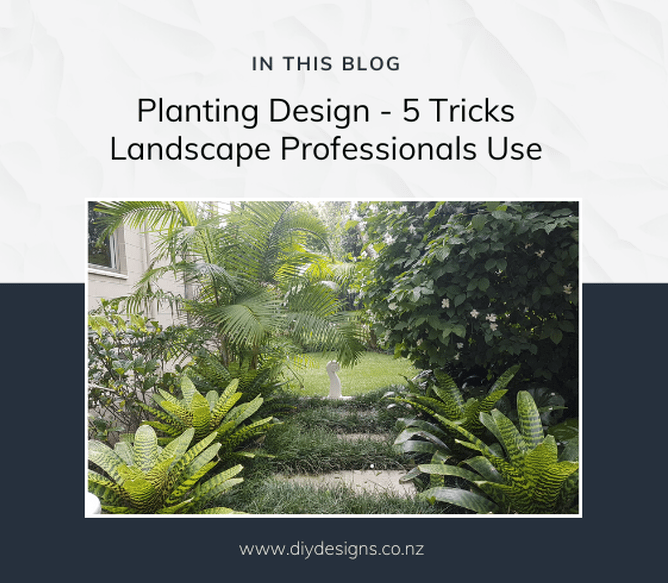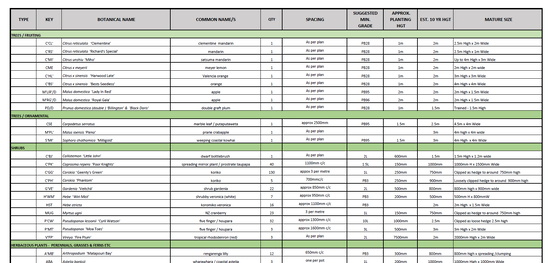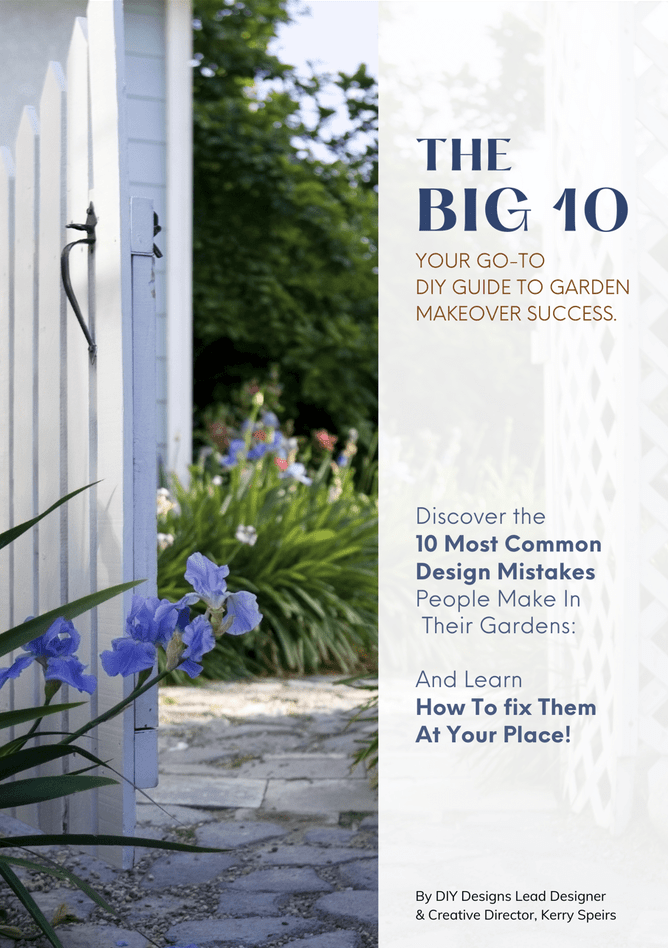Planting Design Tricks & Tips
A good planting design or interesting planting scheme is what brings a garden to life!
Read any plant-focused garden design blog (except this one) and it’ll bang on how if you want your garden planting to do well, it's vital that you choose the right plant for the conditions and space, and the importance of selecting appropriate species for your site conditions. That’s excellent advice, but well covered already.
Let’s assume you’ve done your research in that space, dig a little deeper, and unlock some simple planting design techniques landscape professionals like me use when they are putting together a planting design or planting scheme. In this blog, you'll learn how to approach the design of your planting scheme the way a garden or landscape designer would. So, let's get started with the first of my planting design tips & tricks.
Planting Design Tricks & Tips #1
Don’t ignore the plant wish list!
Let’s face it, it’s your garden, therefore the final plant palette has to include the plants you either love, want to grow, or that you think look good and are going to give your garden the wow factor you are looking for. Otherwise, at some point, you're likely to squeeze them in any way, which can lead to a cluttered and unconsidered outcome. Ie it'll look messy!
So, first up, write them down. Yep, all of them! This doesn’t mean you’ll use them all, but making a plant wish list provides a great starting point for your plant selection process. I
With your plant wish list in hand, you can then begin to consider suitable spots for these plants in your garden, be it still in the planning stages or already constructed and awaiting planting.
Then, if you find you don't already have suitable spaces, you can either modify the garden conditions to accommodate your preferred plants or do some research to find substitute plants with similar attributes that will work in your localised conditions.
For example, if you have clay soil and would like to grow lavender, which prefers free-draining soil, you could build a raised bed filled with a free-draining soil mix, or choose to grow a plant that will give a similar effect, but is less fussy about drainage, such as Salvia leucanthe.
The other reason making a wish list is such a good tip, is that your initial wish list can be developed into a basic plant schedule. Professional landscape designers use a plant schedule to tell clients how many plants they need to purchase.
Create your plant list in Excel (or a similar program) and, like in the example below, you can add extra columns for information such as quantities, spacings, ultimate size etc. You can use a plant schedule as a shopping list when you head to the nursery so you won't buy too many plants and blow the landscaping budget. Having a defined shopping list for your plants will also help keep you on track if you have to make on-the-spot substitutions as you can look for plants that have a similar ultimate size and visual look/characteristics, so they can perform the intended function.
Planting Design Tricks & Tips #2
Consider ‘why’ before ‘what’.
Visually, plants are like the icing on a cake, often considered the ‘finishing touch’ to a garden. However, lightbulb moment, garden designers consider the plants first! Well, not the actual plants, but the function the plants are going to serve within the finished landscape.
Doing this means that if, for example, you need a 3m high, evergreen hedge along the boundary to screen out the nosy or noisy neighbours, you can plan an adequately wide space for it at the outset. Because the taller the plant, the more depth of space it will need. A thick, dense, tall hedge will be at least 1m wide once mature!
You can consider your actual hedge species later if there’s nothing suitable already on your wish list. But, If you ignore plant function until the hardscaping or new lawn is in-situ, your options around plant species shrink to what will grow in the space you have ‘left’.
Planting Design Tricks & Tips #3
Choose your tallest plants first - design from top to bottom!
Planting design in nature, i.e. a natural forest, is layered and quite complex. We echo this layering in our cultivated garden schemes with tiered plantings. While there are a lot of them, for this blog, let's break it down into 3 simple tiers.
Trees /canopy
Shrubs/feature plants
Groundcovers/filler
The taller plants in your garden, such as trees and screening hedges, which form the canopy and vertical walls of your space typically have the largest root systems and spread, and so will require the most space. The ultimate size of these 'canopy' plants affects the growing conditions of all the other plants in your garden.
Therefore, a good trick to know when planning a successful planting design is that you should choose your tallest plants first, and then work your way down through the ‘layers’ of underplanting. You can use that wish list again here!
Then comes the underplanting, also known as under-story planting. These are the plants that sit below the leafy canopy or in the shade of your taller plants. Depending on the complexity of your planting scheme, this can consist of a range of other 'plant layers'.
Choose plants for the ‘shrub’ layer second. This layer often contains a mix of smaller hedges and shrubs that frame up and divide spaces, and fill crucial roles such as screening eyesores within the garden or dividing up spaces. This layer contains both both feature and filler plants.
Feature plants in the shrub layer have more visual importance, select these before the filler plants. Think of them as the stars of the show. These are the plants with the most stunning flowers, foliage, or form.
Filler plants, chosen next, provide more of a support role. Ie, the plants with insignificant flowers but pack a punch with heady perfume, or that have seeds or berries that will attract birds to your garden.
Finally, choose your groundcovers. These are the lowest layer of plants in your garden planting scheme and are often used in massed or group plantings for both impact and weed suppression. They can include plants such as the soft and textural Asplenium bulbiferum ferns you suddenly see and enjoy when those gorgeous hydrangea go dormant over winter. You can also use spreading, ground-skimming, groundcover plants such as Ajuga and suppress weeds and stop birds flicking mulch onto your paths and driveways
Whether you are planning plants for the garden in its entirety, or tackling one garden bed at a time, design using this layering technique. By choosing your tallest plants first and designing from top to bottom, you can ensure there’s enough space for the larger plants you want or need, such as a leafy shade tree at the patio edge, while still having good growing conditions for any plants on your wish list. Because you won’t want that tree canopy to ultimately spread over the area where you plan to place your sun-loving roses!
Planting Design Tricks & Tips #4.
The ‘One-Two’ planting trick.
Less is more, which is great news if you are a novice or newbie gardener. When chosen well, you really don’t need many plants to make a big impact. This is why planting is often considered the biggest bang for your landscape buck.
To be clear - I'm not talking about just a few sparsely scattered plants in a sea of bark. I'm talking about one of the easiest and most successful methods of planting design which is super simple, and it's low maintenance! It’s a successful planting design trick known as the ‘One-Two’.
This is a two layered, two-plant species scheme which is successful because it offers great visual contrast. It can be used in a small garden area or on a much larger scale if you have more ground to cover. Here’s what you do:
Choose your taller feature plant such as a tree, palm or large shapely shrub. This is your ‘one’ and it will give your planting scheme height and drama. Then, simply underplant this with a mass of one other, much lower-growing plant species. This is your ‘two’. It’s that simple!
In a subtropical garden you could use Cycus revoluta underplanted with massed Gardenia radicans or for a New Zealand native theme Nikau palm underplanted with massed Coprosma repens ’Poor Knights’. A favourite one-two combo of mine is white-trunked birch trees with soft carex grasses massed below.
Planting Design Tricks & Tips #5.
Play on Scale
Another simple but effective planting design trick that you can use if your plant knowledge is limited is to combine a few plant species with similar foliage forms, playing on scale for impact. Let’s use strappy plants as an example.
Using the layering selection technique (in #3) choose your tallest plant first. Let’s say a broad-leaf cabbage tree suits your planting theme and growing conditions. Next, consider a feature plant for the understory that has a similar, smaller form, such as a nice flax. If you wanted a bit of flowering interest, you might add dietes or a similar strappy, flowering plant from your wish list. Finally, add a lower groundcover of a suitable height, such as some fine mondo grasses.
This scheme will be visually successful because all the plants have a similar form and there’s also impact created by the contrast of scale in both the height of the plants and the variance in foliage size. Because there is cohesion in the foliage form, the scheme doesn’t look messy or cluttered either. This idea also works with the one-two trick, you’d just limit it to two plants.
Feeling more knowledgeable about how to design your own planting scheme?
You can learn even more about this topic and how to design the rest of your garden like a pro with the garden tips and tricks in our info-packed eBook!
It's a must-read if you want to improve your garden without overspending because there are 10 common mistakes people make when designing gardens, heck, even some professionals make these mistakes; and they are most likely the reason you're not satisfied with how your garden looks and feels.
What are they and how do you fix them? FIND OUT HERE
Want 1:1 Planting Design Help?
Plants, and by extension gardens, are living things and when you’re ‘done’ planting your garden is really just getting growing.
It's going to change and evolve as the plants mature. That makes planting design one of the trickiest aspects of landscaping to get right. If you're not confident about getting it right, call in the professionals. DIY Designs can help you with plant selection and all manner of landscape design or planting design solutions. Just get in touch, we'd love to help.



